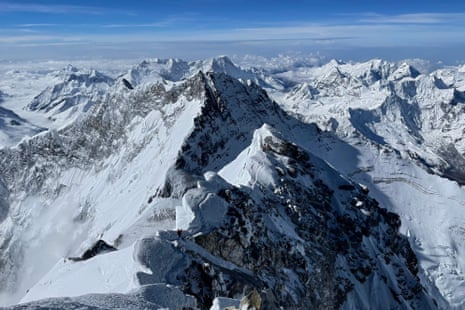It’s one of the more unedifying challenges involved in scaling to the highest point on Earth – how best to relieve oneself in the freezing, inhospitable environment of Mount Everest.
That question is about to become slightly more complicated as climbers prepare for a change in protocol when the season gets under way next month, with a new rule about removing their own faeces as they trek up and down the mountain.
Pollution from human waste on Everest has been a problem for many years. In response, this season authorities have mandated that climbers must remove their faeces from the mountain using biodegradable bags.
An official at the Pasang Lhamu rural municipality, one of the authorities responsible for the Nepalese side of the mountain, said it is a permanent rule change.
“By mandating the use of biodegradable poop bags, we hope to initiate significant positive change and protect this world heritage site from further damage caused by … human waste pollution,” chairman of the municipality Mingma Sherpa wrote in an email.
“This will be a permanent practice from the next season of Everest Summit.”
Allan Cohr is an Australian mountaineer and the owner of Everest One, which runs expeditions on the mountain.
He is preparing for another trip this season and said his company’s head Sherpa has been given details of how the rules will work by the Sagarmatha Pollution Control Committee (SPCC), the Nepalese authorities that manage waste in Everest’s trekking area.
“They are issuing each climber with a number of wag bags, so they’re the waste alleviation gelling bags. They have a chemical composition inside which hardens the faeces and removes the odour,” Cohr said.
“They hand them out to all climbers and all Sherpas, you use those bags in Camp I, Camp III and Camp IV or in any other location where you have to go … and then my understanding is that everything gets gathered in Camp II and flown out.”
“They are saying they are going to check the bags, whether they do that I don’t know.”
Previously, climbers were expected to dig holes as a way of disposing their waste.
The Nepal Mountaineering Association, which can issue permits to climbers, is yet to update its guidance. Its website asks people to “defecate in individual small holes that you cover with snow after use”. Groups are told to use temporary latrines dug at least 20cm deep.
If climbers are unable to dig holes, then the association asks that human waste is left exposed to the sun “this way decomposition will be quicker”.
Cohr welcomed the rule change. “Up on the mountain … it’s so cold with the lack of oxygen and natural microbes that faeces just doesn’t decompose, it just sits where it is laid. It can sit there for eternity.”
Mountain climber and writer Alan Arnette who scaled Everest in 2011 is sceptical about whether authorities will see it through.
“Nepal has a long history of making these announcements … I don’t know if they are going to enforce it.”
“The wag bags should have been done decades ago. It’s been done on Denali in Alaska, in Aconcagua in Argentina and on Mount Vinson in Antarctica,” Arnette said.
He was also concerned about Nepal’s ability to appropriately dispose of large amounts of human waste.
“Nepal will have to go through a learning curve on this.”
In March, the only surviving member of the mountaineering expedition that first reached the summit of Mount Everest criticised the number of people on the world’s highest peak saying it was too crowded and polluted.
